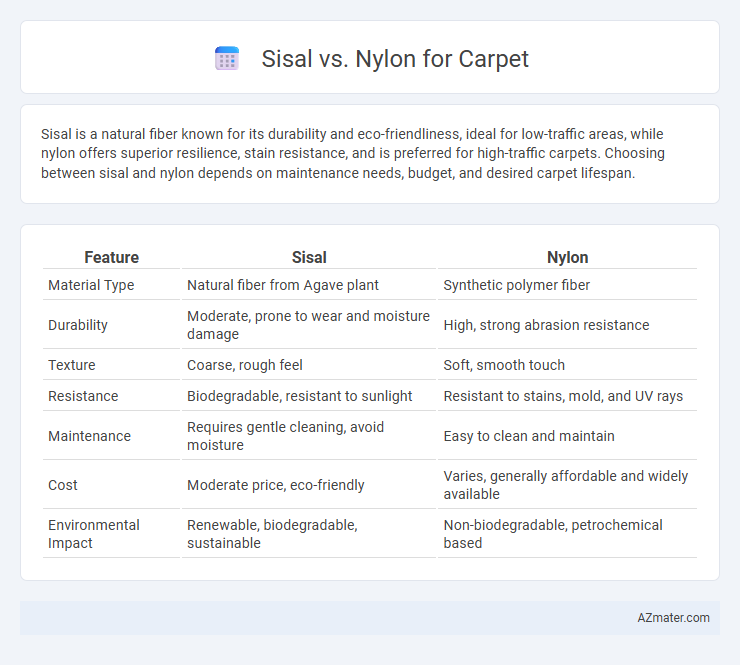Sisal is a natural fiber known for its durability and eco-friendliness, ideal for low-traffic areas, while nylon offers superior resilience, stain resistance, and is preferred for high-traffic carpets. Choosing between sisal and nylon depends on maintenance needs, budget, and desired carpet lifespan.
Table of Comparison
| Feature | Sisal | Nylon |
|---|---|---|
| Material Type | Natural fiber from Agave plant | Synthetic polymer fiber |
| Durability | Moderate, prone to wear and moisture damage | High, strong abrasion resistance |
| Texture | Coarse, rough feel | Soft, smooth touch |
| Resistance | Biodegradable, resistant to sunlight | Resistant to stains, mold, and UV rays |
| Maintenance | Requires gentle cleaning, avoid moisture | Easy to clean and maintain |
| Cost | Moderate price, eco-friendly | Varies, generally affordable and widely available |
| Environmental Impact | Renewable, biodegradable, sustainable | Non-biodegradable, petrochemical based |
Introduction to Sisal and Nylon Carpets
Sisal carpets are made from natural fibers derived from the agave plant, offering eco-friendly durability and a distinctive textured appearance ideal for high-traffic areas. Nylon carpets consist of synthetic fibers known for exceptional resilience, stain resistance, and ease of maintenance, making them popular in both residential and commercial settings. Comparing sisal and nylon highlights differences in sustainability, comfort, and longevity suited to various lifestyle needs.
Material Origins: Natural vs Synthetic
Sisal carpet fibers originate from the natural leaves of the Agave sisalana plant, making them biodegradable and eco-friendly, while nylon fibers are synthetic polymers derived from petrochemicals, known for their durability and resistance to wear. Natural sisal offers a textured, organic aesthetic but is less stain-resistant and more prone to moisture damage compared to nylon, which excels in resilience and maintains color vibrancy over time. When choosing between sisal and nylon carpets, consider the environmental impact and maintenance requirements linked to their distinctive natural and synthetic material origins.
Durability and Longevity Comparison
Sisal carpets, made from natural agave fibers, offer exceptional durability due to their dense weave and natural resistance to wear, making them ideal for low to medium-traffic areas. Nylon carpets outperform sisal in longevity because of their synthetic fibers' superior resilience to abrasion, staining, and fading, maintaining appearance in high-traffic zones. While sisal provides environmentally friendly durability, nylon guarantees extended lifespan and sustained aesthetic appeal under heavy use.
Texture and Comfort Underfoot
Sisal carpets offer a natural, coarse texture that provides firm support and durability underfoot, ideal for high-traffic areas seeking earthy aesthetics. Nylon carpets deliver a softer, plush texture with enhanced cushioning, making them more comfortable for prolonged standing or walking. The choice between sisal and nylon depends on whether a harder, natural feel or a softer, more cushioned carpet surface is preferred for comfort.
Stain Resistance and Maintenance Needs
Nylon carpets offer superior stain resistance compared to sisal due to their synthetic fibers that repel liquids and allow easier cleaning, making them ideal for high-traffic or spill-prone areas. Sisal, a natural fiber, tends to absorb stains quickly and requires more frequent and gentle maintenance to prevent damage from moisture and harsh cleaning agents. Regular vacuuming and prompt spot treatment are essential for maintaining sisal carpets, while nylon carpets can tolerate more aggressive cleaning and stain-resistant treatments.
Environmental Impact and Sustainability
Sisal carpets are biodegradable and sourced from renewable agave plants, making them a more sustainable choice with minimal environmental impact compared to nylon, which is derived from petroleum and involves energy-intensive manufacturing processes. Nylon carpets contribute to pollution and are less eco-friendly due to their non-biodegradable nature and reliance on fossil fuels. The durability of nylon can extend carpet life, but sisal's natural fiber composition supports better ecological balance and reduced waste in carpet production.
Cost Differences: Budget Considerations
Sisal carpets generally cost less upfront than nylon carpets, making them a budget-friendly choice for natural fiber enthusiasts. Nylon carpets offer superior durability and stain resistance but come at a higher price point, reflecting their synthetic composition and advanced manufacturing. Homeowners prioritizing long-term value often weigh the initial affordability of sisal against nylon's extended lifespan and maintenance savings.
Aesthetic Versatility and Design Options
Sisal carpets offer a natural, earthy texture with a neutral color palette that complements rustic and minimalist decor, while nylon carpets provide extensive aesthetic versatility through a vast array of colors, patterns, and finishes suitable for modern and high-traffic areas. Nylon's ability to be dyed in vibrant hues and incorporate intricate designs makes it ideal for personalized or bold interior styles, whereas sisal's organic fibers deliver a more subdued, classic look. Choosing between sisal and nylon depends on the desired visual impact and the flexibility needed in carpet design options.
Best Applications for Sisal vs Nylon
Sisal carpets excel in high-traffic areas such as entryways, hallways, and living rooms due to their natural durability, eco-friendliness, and textured surface that provides excellent grip. Nylon carpets are best suited for versatile environments including bedrooms, offices, and commercial spaces because of their superior stain resistance, softness, and ability to maintain color vibrancy over time. Opt for sisal when prioritizing sustainability and rugged wear, while nylon offers better comfort and versatility for diverse interior settings.
Choosing the Right Carpet: Sisal or Nylon?
Sisal carpets offer natural durability and eco-friendliness, making them ideal for low-traffic areas and homeowners seeking sustainable materials. Nylon carpets provide superior stain resistance and resilience, perfect for high-traffic zones and households with pets or children. Evaluating factors such as traffic level, maintenance requirements, and environmental concerns ensures selecting the best carpet fiber for your space.

Infographic: Sisal vs Nylon for Carpet
 azmater.com
azmater.com